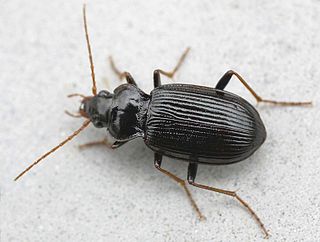Related Research Articles
Calopteryx exul is an endangered species of damselfly in the family Calopterygidae. It is found in Algeria, Morocco, and Tunisia. The largest populations found were located in Northeast Algeria. Its natural habitat is along rivers that have fast flowing water, which are threatened by pollution.
Hibernicus exul was an anonymous Irish Latin poet, grammarian, and dialectician. His works include a comic mock epic, a panegyric to Charlemagne, epigrams of advice to young scholars and a poetic overview of the seven liberal arts.

Grevillea exul is a species of flowering plant in the family Proteacae, endemic to New Caledonia.

Paphiopedilum exul is a species of orchid endemic to peninsular Thailand. This orchid is found growing in humus-filled crevices, and is not difficult to grow or flower. Its greenish yellow flowers appear from February to May.

Nebria is a genus of ground beetles native to the Palearctic, the Near East and North Africa. There are more than 500 described species in Nebria.

Nebria brevicollis is a species of ground beetle native to Europe and the Near East. In Europe, it is found in all countries and islands except the Azores, the Canary Islands, the Channel Islands, Franz Josef Land, Gibraltar, Madeira, Malta, Monaco, the North Aegean Islands, Novaya Zemlya, San Marino, the Selvagens Islands, Svalbard and Jan Mayen, and Vatican City. It has now been reported as introduced in western Oregon, U.S.A., where it has been found in highly disturbed sites as well as in native old-growth forest stands. It has also now been found in Washington State, Northern California, as well as in Southern British Columbia, Canada(See external link to iNaturalist, below). This species is most abundant between October and December, then from January through mid-May. Although Nebria brevicollis is widely considered to be solely carnivorous, multiple small studies made by enthusiasts have proven that many Nebria brevicollis will resort to eating various types of fungi that can be found in the soil they live on/around. Studied made by the same individuals have also shown that Nebria brevicollis are semi-social, and will often work together when faced with certain obstacles.

Nebria livida is a species of ground beetle with two subspecies:
Coleophora exul is a moth of the family Coleophoridae. It is found in southern Russia.

Nebriinae is a subfamily of ground beetles in the family Carabidae. There are about 12 genera and more than 840 described species in Nebriinae.
Nebria aetolica is a species of ground beetle in the Nebriinae subfamily that can be found in Albania, Greece, and North Macedonia.
Nebria fuscipes is a species of ground beetle in the Nebriinae subfamily that can be found in Hungary, Poland, Romania, Slovakia, and Ukraine. The species is black coloured and is 13 millimetres (0.51 in) long.
Nebria punctatostriata is a species of ground beetle in the Nebriinae subfamily that can be found in Portugal and Spain.
Nebria rubripes is a species of ground beetle in the Nebriinae subfamily that can be found in France and Spain.
Nebria angusticollis is a species of ground beetle in Nebriinae subfamily that can be found in the Alps of France, Italy, and Switzerland.
Nebria cordicollis is a species of black coloured ground beetle from Nebriinae subfamily that can be found in Switzerland, Italy, and Germany. The species is about 5 millimetres (0.20 in) long.
Nebria elbursiaca is a species of ground beetle in the Nebriinae subfamily that is endemic to Iran.
Abacetus exul is a species of ground beetle in the subfamily Pterostichinae. It was described by Tschitscherine in 1900.
The New Caledonian nightjar is a poorly known species of nightjar in the family Caprimulgidae. It is endemic to New Caledonia.
Angophora exul, commonly known as the Gibraltar rock apple, is an endangered tree native to a small area in eastern Australia.
References
- ↑ "Nebria exul Peyerimhoff, 1910". Catalogue of Life. Retrieved 2023-04-08.